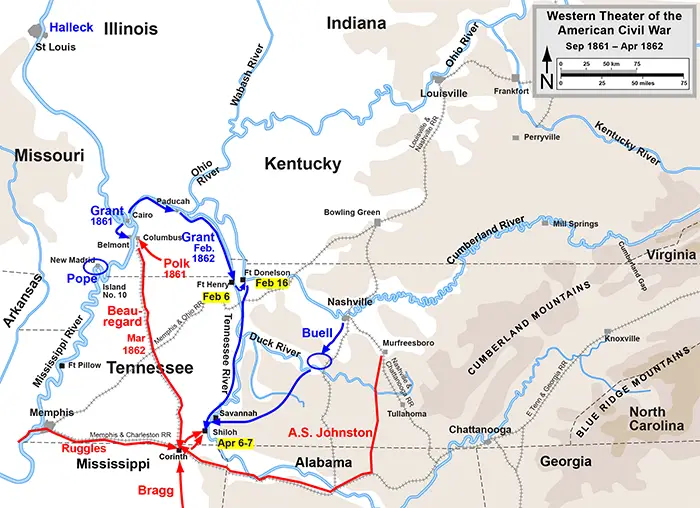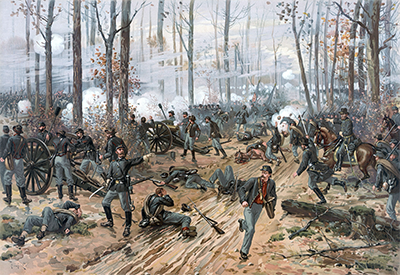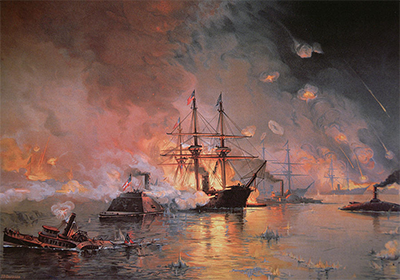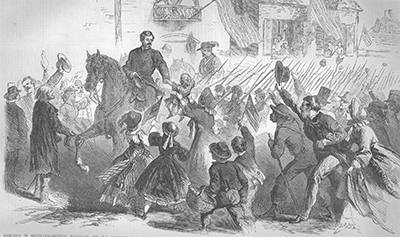The American Civil War
Part 2: McClellan Ascendant
McClellan and Scott clashed when the former publicly made known his dislike of Scott's Anaconda Plan, a multi-pronged strategy for convincing the South by both military and economic means to offer surrender. When Scott resigned, Lincoln elevated McClellan to replace him. McClellan responded with a plan of attack all his own. He took his time developing it and implementing it. Smaller engagements occupied armies on both sides for the next few months, and then winter halted the pace of the fighting. Early in 1862, Union troops in the West embarked on a campaign to capture Tennessee. 
Fort Henry was on the Tennessee River. Close by, on the Cumberland River, was Fort Donelson. Commanding the invasion force for the Union was Brig. Gen. Ulysses S. Grant. Union troops, both army and navy, succeeded in February in taking both forts, and the way to Nashville was open. Union troops entered the strategic city not long afterward. After taking Fort Henry and Fort Donelson, Grant and his Army of the Tennessee had moved deep into Tennessee. In early April, the army was encamped at Pittsburg Landing, on the western bank of the Tennessee River. Grant was waiting for reinforcements from the Army of the Ohio, led by another major general, Don Carlos Buell. General Albert Sidney Johnston, the Western Confederate commander, knew of the impending reinforcement and wanted to prevent it. He and his second-in-command, Gen. P.G.T. Beauregard, launched a surprise attack on Grant's forces on the morning of April 6. They had come from Corinth, 20 miles to the southwest, and had intended to launch their attack two days earlier but had been delayed by muddy roads. The delay meant that they at the last of their rations before the battle began. 
The attack commenced around the Shiloh church region on April 7, 1862. The element of surprise gave the Confederate troops a decided advantage in the early going. However, many on both sides were inexperienced in combat and many who were experienced had not been through the kind of bloody hand-to-hand fighting that ensued. At midday, Union troops rallied for a counterattack. Johnston was shot in the leg during this counterattack (after taking over from a subordinate who refused to lead his troops into the fighting), and he later died. The following day, Grant and Buell coordinated an attack between their two armies that drove the Army of the Mississippi away. 
Also in 1862, the Union Navy's David Farragut led an invasion force that seized the vital port city of New Orleans. Confederate troops had a sizable contingent of gunboats patrolling the Mississippi River and had fortified the twin strongholds of Fort Jackson and Fort St. Philip. Farragut had his own sizable contingent of boats and troops and began bombarding the forts on April 18, 1862. The bombardment continued for six days, during which time Union troops also severed a chain blocking passage up the river. With nothing to stop the Union boats' progress, upriver they went. Both forts surrendered on April 25, and Maj. Gen. Benjamin Butler led his infantry into the city to occupy it. Next page > Along the Peninsula > Page 1, 2, 3, 4, 5, 6, 7, 8, 9, 10 |
|
Social Studies for Kids
copyright 2002–2025
David White



 Lincoln replaced
Lincoln replaced 
